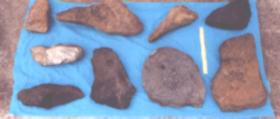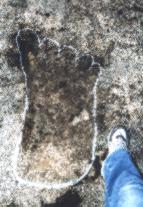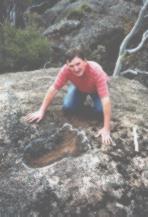Pyramids In The Pacific

The Unwritten History Of Australia
Chapter 1
|
Footprints From The Dreamtime Australia's Unknown Stone-Age Past |
"When Giant fellas alive, them big animals still bin
walkabout this country, Ground shake when he
walk. He eat peoples"
Wullagun
Tribal Elder of the Yabuduruwa people
of Arnhem Land,
concerning the Nagarun, a race of giant people
that once roamed the region.
|
Chapter
1 Images
|

|
Above some of the Bathurst NSW Stone-Megatools
Recovered by Rex Gilroy
One day in 1931 on a windswept sandhill, the remains of the shoreline a long-vanished lake about 100km south of the Murray River, at Glenloth, Victoria, John Gibbs, a 10 year old local boy, was playing in the shell grit of an ancient Aboriginal midden. In a basin of the sandhill amid the debris of broken shells, he picked up a large fragmenting football-size lump of petrified mud. Protruding from one of the fragments, he found a small bronze coin. Years later a Melbourne Museum numismatist would identify it as Greek, and that it had been minted in Egypt during the reign of the Greek Ptolemy Philometor the 6th in the 2nd century B.C.
There will be more to say about this coin in a future chapter. The suggestion as to how the coin turned up where it was found is of course that it had been left behind by ancient visitors; Greek explorers perhaps, or even Arabs, Indians or Malayans with whom the Greeks traded.
Similarly, in 1961 a family picnicking on the Daly River, west of Katherine in the Northern territory, found a gold scarab, an object of worship of the ancient Egyptians. How did this valuable ornament find its way to such a remote location? One might ask the same question of a carved stone head of the ancient Chinese Goddess Shao Lin {protectress of mariners at sea} removed from a beachfront hillside at Milton, on the New South Wales far south coast in 1983.
The many ancient rock inscriptions of Phoenician, Libyan, Egyptian, Celtic, Scandinavian and other origins that have turned up across Australia. Relics, rock inscriptions and megalithic ruins left here by seafaring adventurers who came here from civilisations now long turned to dust. They sailed in search of new lands rich in gold, silver, copper and tin, precious stones and pearls, using the worlds' oceans as watery highways.
It is one of the objectives of this book to demonstrate that these people not only discovered and mined the mysterious "great south land" and its neighbours, but established colonies {some of which may have survived for generations} and were large and important enough to establish a local ruling class. By the time they vanished they had influenced the cultures of the native peoples of the region, leaving behind them ghostly megalithic ruins of temples, tombs and pyramids and rock scripts in a host of ancient tongues; relics that continue to perplex conservative historians and question the dogma that the peoples of the ancient world lacked the ability to construct and navigate oceangoing water craft.
The fact is that people were putting to sea centuries before the invention of a written language, and that the water craft they sailed in were far from flimsy. Although my book concerns the 'unknown' history of Australia's discovery and exploration, it also is to some degree a history of ancient mining activities throughout the Australian-West Pacific region. In forthcoming chapters, I shall demonstrate that, at various times in antiquity, and during the Copper and Bronze ages in particular, Australia's coastline saw the sails of mineral-seeking peoples from many ancient exotic lands.
|
Pyramids
in the Pacific Images Ch
1
|

|

|

|
|
Giant Hominid Footprint |
The "King Kong" of Kanangra |
Giant Hominid Footprint |